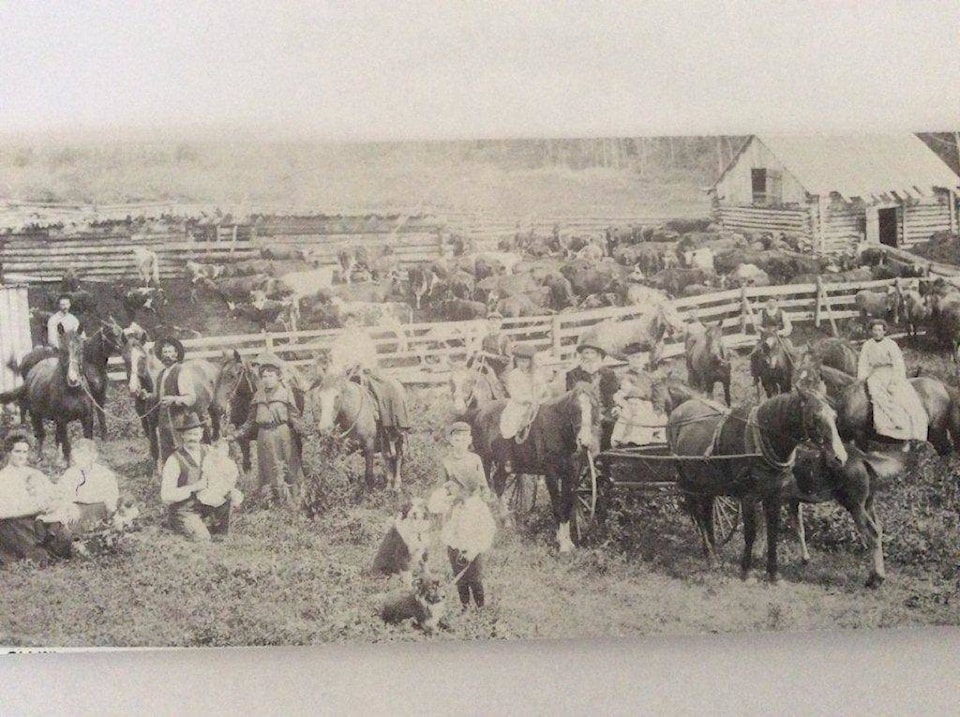By Mike Rainone for the News
The rugged, challenging, and colourful saga of the first settlement of the vast lush and rolling countryside surrounding the settlement of Ponoka would begin in 1890. Among the initial Pioneer families arriving in the Elkhorn district north west of the community were the Ogilvies, Wrights, Rowlands, Taylors, Clinks, Frys, and Smiths, who would soon be joined by countless others, many of whose ongoing generations have remained in this area over the decades to play an integral part in the amazing growth and progress of our town and county.
Like the extremely motivated John Taylor, many more families would load up their worldly belongings and make the long and arduous trip to the west from Nova Scotia. After several stops along the way they were finally given the opportunity of slowly but boldly beginning to establish their new homesteads in the wilderness close to Wolf Creek, while over the years always encouraging others to join them. The district was originally the location of the Sharphead First Nations Reserve, but after being abandoned by the Government in 1890, four sections were made available for homesteading. The name Elkhorn was likely dedicated to the massive herds of Elk who roamed freely in the vast area, and as the district became established a large influx of settlers began arriving from the United States and elsewhere, resulting in the need for the first school being built in 1902 as well the establishment of the Free Methodist Church in the early 1920s.
The saga of the John Taylor family
It was around the year 1890 that John Taylor, a native of Little River, Musquodobit, Nova Scotia would make the big decision to join many others and partake on a harvest excursion to the west country. After buying a $10 train ticket to Manitoba a large group would stop to work during the fall harvest, but would later hear the exciting news that a new branch railway line was building north from a cow town called Calgary, and that Alberta, NWT were blessed with a much better climate than Eastern Canada. It was after the winter was over that James and his wife Ellen and three children would head west with very little money in their pockets, but with strong hearts and hope that they would find new opportunities on the Prairies. The little family landed at the end of the steel line in Red Deer in the spring of 1891, and then made their way to the Strawberry Plains to the north.
The Taylors would take their first homestead one mile east of Railway Siding 12, which would later become the Town of Lacombe. “Johnnie,” as he would become very well known to all, would spend the entire spring and summer with his son Nathan building the C and E Railway north to Edmonton. With the money they made they would purchase 10 heifers to calve in the spring. Many years later the Taylor Family story in the Crestomere Sylvan Height’s Heritage History Book, it would vividly recall that during their countless long and tough hours of work along the C and E line to Edmonton there were so many dead horses that had succumbed to the dreaded Swamp Fever that was ravaging the prairies. They willingly joined the other new settlers in the area, and armed with axes, saws, teams, and sleds they cut and hauled logs to build the much needed first school in the tiny Hamlet of Lacombe. After a few years there the steadily expanding Taylor family would sell their farm and moved to the Elkhorn district NW of Ponoka. In 1898 the Taylors would purchase a Canadian Pacific Railway quarter on the N.W. 25-42-27 in the district known as Wilmot, and would later build a larger house beside a lovely spring. Over the next few years, he and his sons, who came later and started their own families, would bring their growing herds of cattle together in the fall to a magnificent setting that was called “The Wintering Place,” on which he would faithfully tend to and expand for the rest of his life. Throughout their busy and active lives Mr. and Mrs. John Taylor would raise a family of 12, including the boys George, Bill, Nathan, and Ernest, as well as daughters Emma (Uhlman), Elizabeth (Gardiner), Maude (Logan), Belle (McLaughlin, Carrie (MacKenzie), Elmira (Dickey), May (Snider), and Della (Michel). As well as sharing the work on the farm, the children all completed their schooling in the area, the boys played on the talented district baseball team, and the whole family were very involved in the community, as well as always being very good friends and neighbours.
Along the way Johnny Taylor and his family would take on many energetic projects that they would share with the district, including operating the first saw mill, which was driven by a water-powered wheel and was later replaced in 1903 with a modern new steam engine. The following winter Johnny and the boys would move their mill to Abe Davidson’s (The old Buckhorn Ranch) where they sawed thousands of feet of lumber at a charge of $5 a thousand plus $2 a thousand for the mill work. Abe would later move the boiler all the way home with his famous ox team. In 1904 the Taylors had a shingle mill shipped in from Nova Scotia to the home place, and for many years nearly every building in the surrounding country and Town of Ponoka would have Johnny’s “Taylor made” shingles on their roofs. One of his last amazing inventions before his death in 1923 was a powerful and unique ditching machine, which was pulled by 24 horses and would turn a farrow three by two feet deep, served as a great plow, and through the years would drain a lot of water off the flats east of his property and would look forward to serving and assisting neighbours and friends in many other ways.
